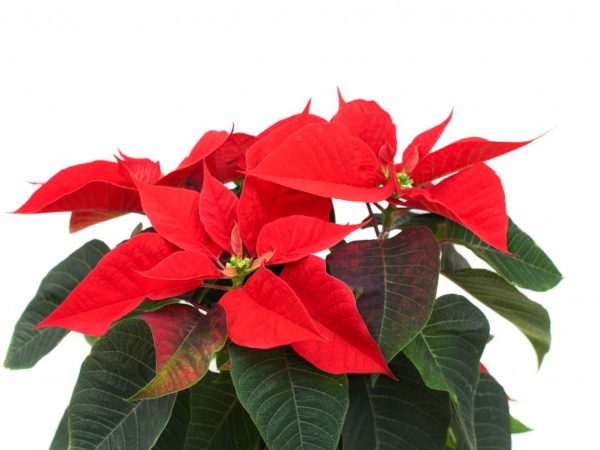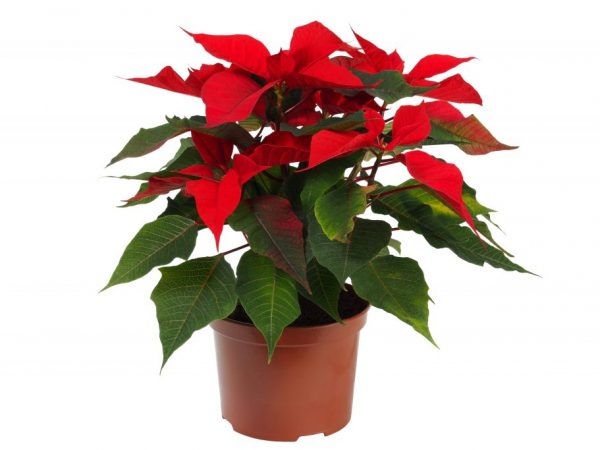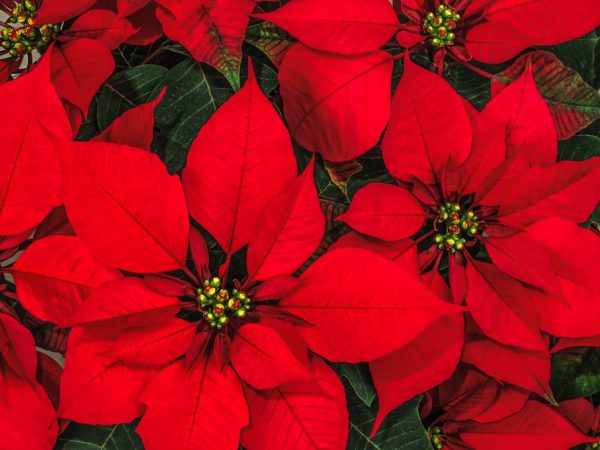Euphorbia the Most Beautiful - how to properly care
The most beautiful Euphorbia comes from sunny Mexico and the central regions of America. It is also called Poinsettia after the American minister who was instrumental in popularizing the plant. Another name - the Star of Bethlehem - is associated with the blooming time of euphorbia - on the eve of the Christmas holidays.

Euphorbia the Most Beautiful - how to properly care
Description of the plant
The most beautiful spurge (Latin Euphorbia Pulcherrima) is a spectacular perennial shrub that can grow up to 3 m in nature.
It is often used in landscaping and is grown at home. There are specially bred decorative forms up to 30-50 cm in height. The elliptical leaves of the plant are decorated with a scalloped edge and an elongated tip. In length, they reach 10-12 cm.
Flowers are small, yellow, growing in inflorescences. The highlight of the Poinsettia is its bright red stipules, which at first glance can be mistaken for flower petals. They really resemble a star in shape and create a festive Christmas mood.
Today, varieties of other shades are also common: pink, coral, orange, beige. The flowering time is from December to February.
All types of euphorbia, when fractured, secrete a cloudy juice that can cause allergic irritation on the skin.
Purchase and adaptation
When purchasing a poinsettia, it is important to remember the thermophilic nature of the plant. You should not buy it on the street from trays in cold weather. Make sure the flower shop is warm enough or the frozen spurge will not bloom and may even die.
Before buying, carefully inspect the euphorbia: it should be free of spots, damage, dry stems and roots.
- At home, set the poinsettia apart from other flowers. If after two to three weeks there are no signs of the disease, quarantine can be stopped.
- For the first month, do not disturb the plant with fertilizing, moving and replanting. It is better not to replant it at all until the end of flowering.
- Provide the milkweed with comfortable conditions: sufficient warmth, no drafts, good lighting, regular but moderate watering.
Growing conditions
Soil selection
The Star of Bethlehem is not demanding on the soil - it is planted in a universal substrate for decorative deciduous plants. You can prepare a soil mixture yourself from sod and leafy soil, adding peat and coarse sand to them (in a ratio of 3: 3: 1: 1). Dry manure is often used instead of peat crumbs.
Humidity
Poinsettia is a tropical flower that needs moderate moisture. It tolerates temporary droughts adequately, reacts gratefully to irrigation from a spray bottle (water should not get on the bracts).
However, you should not allow waterlogging so as not to provoke illness.Airing the room is recommended, but drafts are strictly prohibited.
Temperature
You need to grow the most beautiful euphorbia in a warm place: in summer - at 22-25 ° С, in winter - at least 16 ° С.
If the flower freezes, flowering will not take place. In addition, temperature jumps are extremely dangerous: one cold draft can stop the growth of euphorbia for a long time.
Lighting

Euphorbia is photophilous
The Star of Bethlehem loves light - it is better to place it in a sunny place on the south side of the house on a stand. This is especially true during the flowering period: with insufficient illumination, bright bracts can fall off.
Care
Fertilizers
The flower is fed 2 times a month. During the rest period, the procedure is stopped. Universal complexes for ornamental plants are used as fertilizers.
Watering
The flower is watered moderately - every 7-10 days. In this case, the top layer of the soil should dry out, but not dry out completely. Use soft, well-settled water at room temperature. During the dormant period (from mid-February to the end of early April), watering is reduced to once a month.
Transfer
At the end of flowering, the stems of the flower are cut off, leaving about 10 cm. At the end of March, the plant is transplanted into a larger pot with fresh substrate. Drainage from broken bricks is laid at the bottom, and then a layer of soil mixture. The poinsettia is well watered, carefully removed from the old container along with an earthen lump and transferred to a new flowerpot. Euphorbia is sprinkled with soil and tamped, placed on a light and warm windowsill.
Pruning and transplanting euphorbia is carried out with gloves so that the juice does not get on the skin and does not cause irritation.
Preparing for flowering
In October and November, spurge is prepared for the appearance of flowers. Daylight hours are artificially reduced to 8 hours, covering the plant with a dark cap. By practicing this procedure two months before Christmas, you can stimulate the Poinsettia to bloom right during the holidays.
Reproduction
Unfortunately, poinsettia is not easy to propagate at home. The only available method is cuttings, but cuttings do not always take root successfully. However, it's worth a try. After transplanting, the shoots will begin to grow back and leaves appear on them. Cuttings are cut to a length of 10 cm and placed in water to drain the milky juice, and then dried well.
For rooting, they are deepened into a moist substrate of sand and peat (you can pre-treat it with a root stimulator). Plants are kept in a greenhouse at a temperature of 24-25 ° C (it is convenient to use a regular aquarium for this purpose). The greenhouse is regularly ventilated, and the soil mixture is moistened. After the roots appear, young milkweed are seated in separate pots and carefully looked after. They will bloom in about a year.
Diseases and pests

The flower must be well looked after
| Problem | Signs | Prevention measures | Treatment |
| Whitefly | White insects with wings, larvae, honeydew, sooty mushroom. | Maintaining moderate humidity, regular ventilation (no drafts). | Adults that fly should be caught with sticky tapes. Wash the milkweed leaves with a soap-alcohol solution, without touching the bracts. Replace the top layer of soil in the pot with a new one In serious cases, use systemic insecticides (Aktara, Actellik, Karbofos). |
| Mealybug | White bloom, like cotton wool, whitish oval insects with many legs. | Regularly inspect the underside of the leaves, remove dry and fallen leaves. | Clean the poinsettia with a soft brush and laundry soap; Spray with special preparations (Tanrek, Admiral, Confidor, Fitoverm). |
| Aphid | Greenish insects, curling and drying of leaves, growth retardation. | Observe quarantine for new plants, lay soil in the freezer before planting, hang mosquito nets on the vents. | Rinse the euphorbia with celandine infusion, soapy water or medical alcohol. Use insecticides: Decis, Intavir, Iskra, Karate. |
| Spider mite | Brown blotches and light yellow spots, a thin cobweb on the seamy side of the leaf. | Correct care: moderate humidity, removal of dry leaves. | Treat with acaricides (Vermitic, Fitoverm, Neoron, Flumite, Aktofit). |
| Root rot | Slowdown in growth, wilting and dropping of leaves, thinning of the stem at the roots. | Avoid waterlogging, disinfect tools and soil (before pruning, planting and transplanting). | At the initial stage - spray with biological products (Glyokadin, Alirin B); transplant euphorbia by removing the affected areas and treating with antifungal agents; in the later stages - treatment with copper sulfate or colloidal sulfur. |
| Powdery mildew | White bloom, small brown bumps. | Observe the correct watering regime (do not water until the topsoil dries out), do not overfeed with nitrogen. | Spray with soap-ash solution, fungicides (Topaz, Fundazol, Skor, Amistar). |

